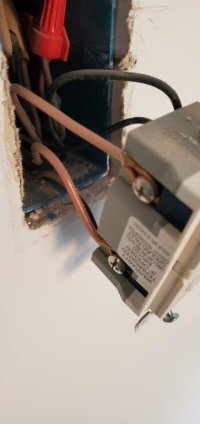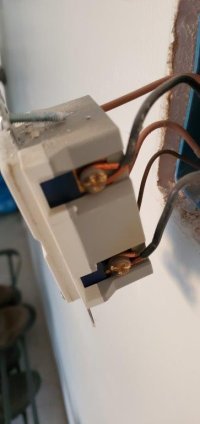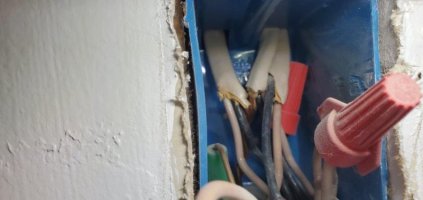Martina
Member
Hello, everyone!
I recently added two receptacles to a 20 amp circuit which changed the order of the GFCI. I decided to replace the old GFCI (that's now in the middle of the run) with a standard receptacle. As I opened the GFCI today, I was met with an unusual picture. Rather than seeing your typical white/black/ground combination, I saw solid brown wires connected to the neutral terminals on the GFCI (see attached image # 1). Upon pondering upon it, I believe to have figured out the issue. This GFCI connects to the exterior circuit of our home, which is hardly ever used except for Christmas, when all of our exterior lights are connected to it. This past Christmas, my husband just happened to put his hand on the wall directly above the GFCI and noticed it was quite hot. Although we don't have elaborate lighting displays, it seems as though the demand was far too high for the circuit. We did take immediate action and reduced the load after letting it cool off, but I believe the continuous exposure to overheating throughout the years has caused the white plastic insulation to turn brown, which leaves me with the question as to whether or not it's safe to continue using this circuit or if we need to rewire the entire exterior circuit. We have continued using the circuit and haven't had any issues with it, but I thought I'd ask to be safe.
Secondly, I have one other question which is unrelated- I'd really like to replace this GFCI with a standard outlet (especially since it may have suffered from overheating). This GFCI has three incoming wires- one supplying power from the breaker and two wires branching off in different directions to feed two separate outlets (see attached image # 3). I'm used to seeing two wires at most (think middle of a run). This is a bit unfamiliar, but I presume it's safe to replace the old GFCI with a standard receptacle and simply keep the current configuration?
Thanks again for everyone's help and feedback!
Martina
I recently added two receptacles to a 20 amp circuit which changed the order of the GFCI. I decided to replace the old GFCI (that's now in the middle of the run) with a standard receptacle. As I opened the GFCI today, I was met with an unusual picture. Rather than seeing your typical white/black/ground combination, I saw solid brown wires connected to the neutral terminals on the GFCI (see attached image # 1). Upon pondering upon it, I believe to have figured out the issue. This GFCI connects to the exterior circuit of our home, which is hardly ever used except for Christmas, when all of our exterior lights are connected to it. This past Christmas, my husband just happened to put his hand on the wall directly above the GFCI and noticed it was quite hot. Although we don't have elaborate lighting displays, it seems as though the demand was far too high for the circuit. We did take immediate action and reduced the load after letting it cool off, but I believe the continuous exposure to overheating throughout the years has caused the white plastic insulation to turn brown, which leaves me with the question as to whether or not it's safe to continue using this circuit or if we need to rewire the entire exterior circuit. We have continued using the circuit and haven't had any issues with it, but I thought I'd ask to be safe.
Secondly, I have one other question which is unrelated- I'd really like to replace this GFCI with a standard outlet (especially since it may have suffered from overheating). This GFCI has three incoming wires- one supplying power from the breaker and two wires branching off in different directions to feed two separate outlets (see attached image # 3). I'm used to seeing two wires at most (think middle of a run). This is a bit unfamiliar, but I presume it's safe to replace the old GFCI with a standard receptacle and simply keep the current configuration?
Thanks again for everyone's help and feedback!
Martina
Attachments
Last edited:



